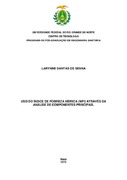Please use this identifier to cite or link to this item:
https://repositorio.ufrn.br/handle/123456789/20244| Title: | Uso do índice de pobreza hídrica (WPI) através da análise de componentes principais |
| Authors: | Senna, Larynne Dantas de |
| Advisor: | Maia, Adelena Gonçalves |
| Keywords: | Escassez hídrica;Análise multivariada |
| Issue Date: | 2-Jun-2015 |
| Publisher: | Universidade Federal do Rio Grande do Norte |
| Citation: | SENNA, Larynne Dantas de. Uso do índice de pobreza hídrica (WPI) através da análise de componentes principais. 2015. 39f. Dissertação (Mestrado em Engenharia Sanitária) - Centro de Tecnologia, Universidade Federal do Rio Grande do Norte, Natal, 2015. |
| Portuguese Abstract: | P ara contribuir no desempenho das políticas e estratégias formuladas por comitês de bacia hidrográfica , índices vêm sendo criados na expectativa de expressar as múltiplas dimensões dos recursos hídricos em u ma forma facilmente interpretável. O uso do Índice de Pobreza Hídrica (WPI) está se difundindo mundialmente, sendo o mesmo formado pela combinação dos subíndices Recurso, Acesso, Capacidade, Uso e Ambiente. A lgumas críticas quanto à f ormação do WPI foram surgindo , de ntre elas destaca - s e a atribuição de pesos dos sub índices, feita por um processo arbitrário atribuindo subjetividade ao critério de seleção. Ao envolver análise estatística, quando se considera as características das variáveis geradas pe la Análise de Componentes Principais (ACP), verifica - se que a mesma é capaz de solucionar esse problema . O objetivo deste trabalho é comparar os resultados do WPI original com o índice gerado através da Análise de Componentes Principais (ACP), par a a indic ação dos pesos dos sub índices aplicáveis na bacia hidrográfica do Rio Seridó (RN e PB) . Conclui - se que o uso da Análise de Componentes Principais na atribuição do s pesos do Índice de Pobreza Hídrica permitiu identificar que os sub - índices Recurso, Acesso e Ambiente são os mais representativos para a bacia hidrográfica do Rio Seridó , e que este novo índice, o WPI’, apresentou faixas de valores mais abra ngentes, permitindo identificar mais facilmente as disparidades entre os municípios. Além disso, a avaliaç ã o dos sub índices na área de estudo tem grande potencial de informar ao tomador de decisão na gestão dos recursos hídricos, as localidades mais críticas e que merecem maiores investimentos nos aspectos analisados, já que o índice em si não permite captar essa informação. |
| Abstract: | To contribute in the performance of policies and strategies formulated by development agencies, indexes have been created in anticipation of expressing the multiple dimensions of water resources in an easily interpretable form. Use of Hydro Poverty Index ( WPI) is spreading worldwide , with the same formed by the combination of sub - indices Resource, access, capacity , use and environment. S ome critics a s to its formation have emerged, a mong them stands out the allo cation of weights of sub - indexes , made by an arbitrary process attributing subjectivity to the selection criteria. By involving statistical analysis, when considering the characteristics of the variables generated by the Principal Component Analysis (PCA), it turns out that it is able to solve this problem. The objective of this study is to compare the results of the original WPI with content generated by Principal Com ponent Analysis (PCA) for the indicati on of the weights of sub - indec es applicable in the Seridó River hydrographic Basin . We conclude that the use of Principal Component Analysis in the allocation of weights of Water Poverty Index has identified the sub - indices Resources, Access and Environment are the most representative for the river basin Seridó , and that this new index, WPI' , presented the most comprehensive ranges of values , allowing more easily identify disparities among municipalities. In addition, t he evaluation of the sub - indec es in the study area has great potential to inform the decision - maker in the management of water resources, the most critical locations and deserve greater investments in the aspects analyzed, as the index itself can not cap ture this information. |
| URI: | https://repositorio.ufrn.br/jspui/handle/123456789/20244 |
| Appears in Collections: | PPGESA - Mestrado em Engenharia Sanitária e Ambiental |
Files in This Item:
| File | Description | Size | Format | |
|---|---|---|---|---|
| LarynneDantasDeSenna_DISSERT.pdf | 2,71 MB | Adobe PDF |  View/Open |
Items in DSpace are protected by copyright, with all rights reserved, unless otherwise indicated.

